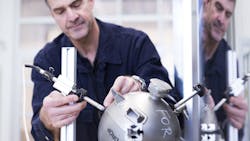Lufthansa Technik AG now using 'green' aircraft fire extinguishers
HAMBURG, Germany - Lufthansa Technik AG is now using a new, faster and more environmentally conscious process to maintain aircraft fire extinguishers at its Hamburg component shop.
A test facility for this work was dedicated recently and put into regular service. The new process primarily reduces environmental risks while also significantly cutting turnaround times.
The job of inspecting the fire extinguisher container no longer involves the time-consuming task of purging the ozone-depleting halon from the container (pressure bottle), temporarily storing it and externally processing it for reuse. Lufthansa Technik is the world's first and only independent maintenance, repair and overhaul (MRO) provider that offers this service on the market.
The pressure bottles of aircraft fire extinguishing systems are usually ball-shaped metal containers that measure between ten and more than 40 centimeters in diameter. Their structural integrity and proper function must be regularly checked. Up to now, they have been emptied and inspected in a water bath using hydrostatic testing methods.
As part of the work, the attachment parts on the container are removed and then welded back into place. The inspection also involves the purging of halon, an ozone-depleting chemical that is still used in aviation for this special purpose due to safety reasons and the lack of alternatives. The halon is then temporarily stored in containers at the Hamburg base.
Authorized service providers then clean and certify it before it is refilled in the bottles. Each step in the process of purging the fire extinguishing agent, temporarily storing it and transporting it poses a potential risk to the environment.
The new process enables the fire extinguishing agent to remain in the pressure bottle throughout the entire inspection, a change that eliminates the complex handling of the chemical.
In the new inspection procedure, the filled pressure tank is placed into a special jig and then heated in a chamber. The pressure in the container rises, and the stress in its metal housing increases. This results in tension in the material, a process that triggers sound waves.
Special sensors acting like microphones are attached to the exterior of the container before the heating process begins in order to pick up these sound waves. Similar to the system used to localize earthquakes in the crust of the Earth the position of every sound source can now be calculated with the help of differences in travel times and conclusions drawn about possible damage to the pressure tank.
These findings are promptly displayed to the inspector in a 3D model on a monitor, exactly localized and color coded on the basis of certain criteria. Afterwards, a decision regarding the continued use or disposal of the pressure tank can be directly made.
